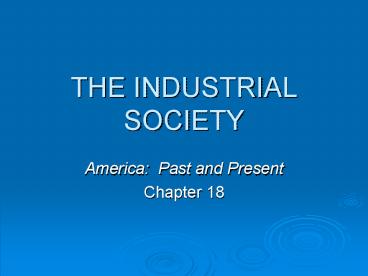THE INDUSTRIAL SOCIETY PowerPoint PPT Presentation
1 / 24
Title: THE INDUSTRIAL SOCIETY
1
THE INDUSTRIAL SOCIETY
- America Past and Present
- Chapter 18
2
Industrial Development
- Late nineteenth-century U.S. offers ideal
conditions for rapid industrial growth - Abundance of cheap natural resources
- Large pools of labor
- Largest domestic market in the world
- Capital, government support without regulation
3
"Emblem of Motion and Power"
- Railroads transform American life
- end rural isolation
- allow regional economic specialization
- make mass production, consumption possible
- lead to organization of modern corporation
- stimulate other industries
- Railroads capture the imagination of the American
people
4
Federal Land Grants to Railroads as of 1871
5
Railroad Construction, 1830-1920U.S. lays over
200,000 miles of track costing billions of
dollars
6
Linking the Nation via Trunk Lines
- No integrated rail system before Civil War
- East linked directly with Great Lakes, West
- Southern railroad system integrated in 1880s
- Rail transportation becomes safe, fast, reliable
- Time Zones and standard time set up in 1883
7
Rails Across the Continent
- 1862--Congress authorizes the transcontinental
railroad - Union Pacific works westward from Nebraska using
Irish laborers - Central Pacific works eastward using Chinese
immigrants - May 10, 1869, tracks meet in Utah
- By 1900, four more lines to Pacific
8
Railroads, 1870 and 1890
9
Problems of Growth
- Intense competition among railroads
- Efforts to share freight in an orderly way fail
- After Panic of 1893, bankers gain control of
railroad corporations - Bankers impose order by consolidating to
eliminate competition, increase efficiency - In 1900, seven giant rail systems dominate
10
Carnegie and Steel
- Bessemer process of refining steel permits mass
production - Use of steel changes agriculture, manufacturing,
transportation, architecture - Large-scale steel production requires
- access to iron ore deposits in Minnesota
- extensive transportation network
- Requirements lead to vertical integration
- definition a type of organization in which a
single company owns and controls the entire
process from obtaining raw materials to
manufacture and sale of the finished product
11
Carnegie and Steel
- 1872--Andrew Carnegie enters steel business
- By 1901 Carnegie employs 20,000, produces more
steel than Great Britain - Sells out to J. P. Morgan 500 mil
- Morgan heads incorporation of the United States
Steel Company 1st 1 billion corporation
12
International Steel Production, 1880-1914
13
Rockefeller and Oil
- Petroleum profitable as kerosene for lighting
- 1859--first oil well drilled in Pennsylvania
- Many uses for Black Gold
- 1863--John D. Rockefeller organizes Standard Oil
Company of Ohio. By 1891 controls 90 of refinery
business - Rockefeller lowers costs, improves quality,
establishes efficient marketing operation - Standard Oil Trust centralizes Rockefeller
control of member companies outside Ohio(
Horizontal Consolidation owned all
competition)
14
The Business of Invention
- Late 19th-century industry births American
technology - An Age of Invention
- telegraph, camera, processed foods, telephone,
phonograph, incandescent lamp
15
Patents Issued, by Decade, 1850-1899
16
The Sellers
- Marketing becomes a science in late 1800s
- Advertising becomes common
- New ways of selling include chain store,
department store, brand name, mail-order - Macy, JC Penny, Sears and Roebuck
- Americans become a community of consumers
17
Working Men, Working Women, Working Children
- Chronically low wages
- average wages 400-500 per year (no minimum wage)
- salary required for decent living 600 per year
- Dangerous working conditions
- railroad injury rate 1 in 26, death rate 1 in 399
- factory workers suffer chronic illness from
pollutants
18
Working Men, Working Women, Working Children (4)
- Discriminatory wage structure
- adults earn more than children
- men earn nearly twice as much as women
- whites earn more than blacks or Asians
- Protestants earn more than Catholics or Jews
- black workers earn less at every level and skill
- Chinese suffer periodic discrimination
- 1879California constitution forbids corporations
to hire Chinese - 1882Federal Chinese Exclusion Act prohibits
Chinese immigration for 10 years
19
Labor Unions
- Early labor unions like fraternal orders
- 1869Uriah Stevens and Terrence Powderly set up
the Knights of Labor - Admit all workers
- 1886--Samuel Gompers founds American Federation
of Labor - seeks practical improvements for wages, working
conditions - focus on skilled workers
- ignores women, African Americans
20
Labor Unrest
- Crossed purposes
- employees seek to humanize the factory
- employers try to apply strict laws of the market
- An era of strikes
- 1877--rail strikes nearly shut down system
- 1880-1900--23,000 strikes
21
Labor Unrest
- 1886--Chicago Haymarket incident prompts fears of
anarchist uprising - Bomb is thrown while police try to break up
meeting - 1892--Homestead Steel Strike, Pittsburgh
- Iron and steel workers seize town after
collective bargaining agreement falls through - 1894Pullman Strike (Eugene V. Debs)
- Train workers strike after a 25 wage cut
bringing train movement to a stop
22
Labor Strikes, 1870-1890
23
Supreme Court Cases
- 1905--Lochner v. New York Right to free
contract - Attempt to restrict hours of bakers
- Cannot restrict hours
- 1908--Muller v. Oregon The case upheld Oregon
state restrictions on the working hours of women
as justified by the special state interest in
protecting women's health - Curt Muller, the owner of a laundry, was
convicted of violating Oregon labor laws by
making a female employee work more than ten hours
in a single day
24
Industrializations Benefits and Costs
- Benefits of rapid industrialization
- rise in national power and wealth
- improving standard of living
- Human cost of industrialization
- exploitation
- social unrest
- growing disparity between rich and poor
- increasing power of giant corporations

